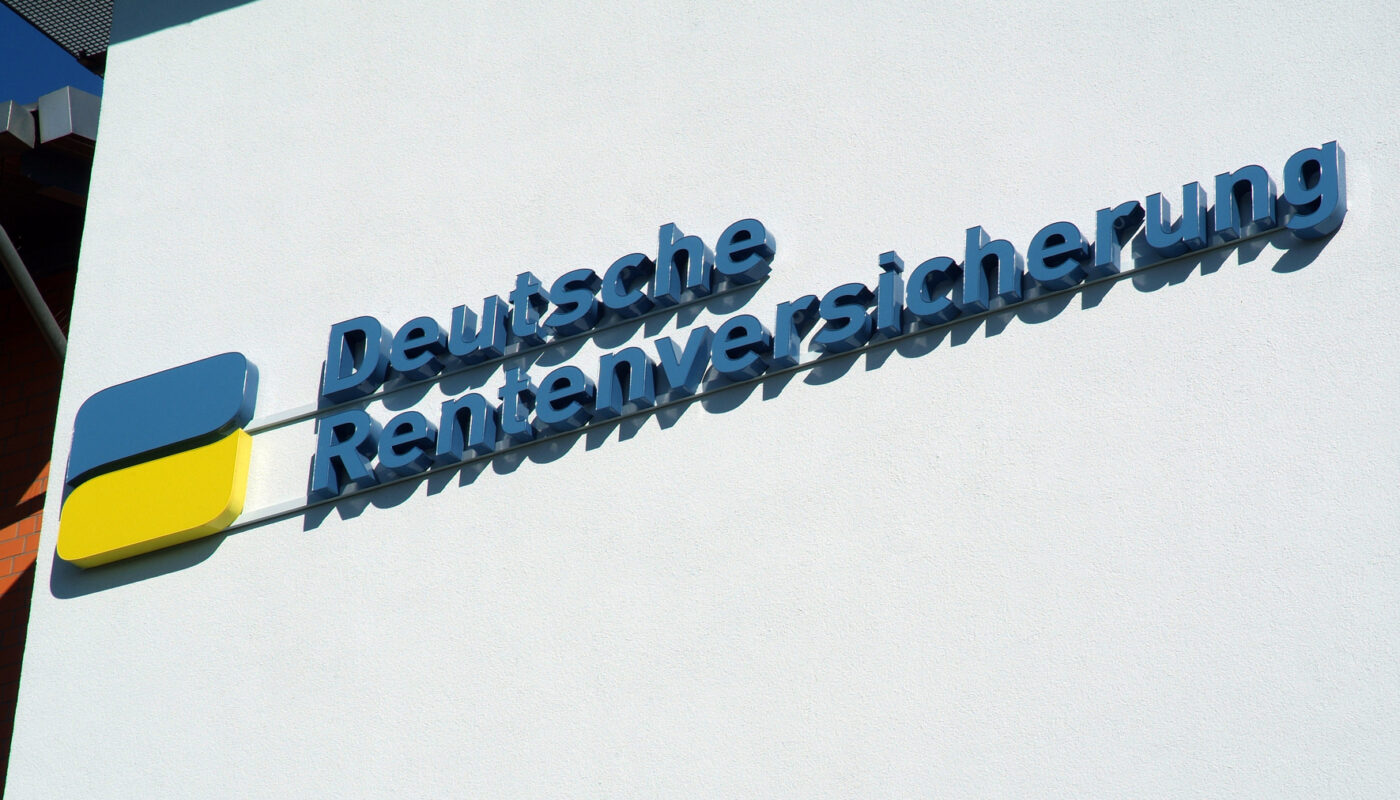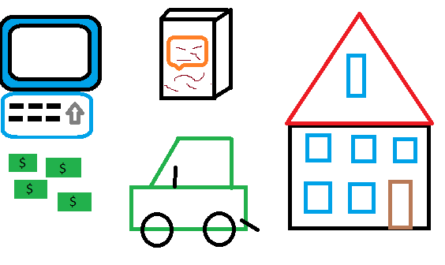Now that we have gone into the calculation of the pension amount using earning points and how the German pension insurance system works, we would like to turn to one of the main problems of old-age provision in Germany: The pension gap. The general tenor “the state pension is secure and will be enough” is not at all true!
Although the state provides a certain amount of security for contributors in old age, this is not enough to be able to continue the previous standard of living. In the pay-in phase, every pensioner has more net income available through his gross salary than later in retirement. Someone born in 1960 who last had a net income of around 1,800 euros will receive a statutory pension of around 1,000 euros net at their official retirement age of 66, which is around 800 euros less than when they were working. This difference is known as the pension gap.
To plug the hole and make up for it, every employee should therefore make private provision. In our example, you need to have enough cash on hand to pay out 800 euros a month until you die. With a current life expectancy for men of just under 79 years, one would have to have a cash balance without interest or return payments of 124,800 euros (8001213) in the account in order to be able to continue financing the approximately 13 years. Of course, one could now say that the typical German has saved up a home in the course of his life and thus no longer has any rent payments or loan installments to pay in old age, but nevertheless one will have to accept certain cutbacks.
The calculation of the pension gap
The demands on one’s standard of living are always very individual. Nevertheless, there are some rules of thumb that everyone can use to calculate their pension gap. In the third phase of life, it can be assumed that only around 80% of the previous net income is still needed, since – as already mentioned – the home has been paid off and additional costs such as commuting to work or caring for the children no longer apply.
Example: Peter Huber last had a net income of around 1,800 euros. This means that 1,440 euros (80%) will be enough to finance his standard of living in old age.
The second rule of thumb is that a typical contributor currently receives around 45% of his last net salary as a statutory pension.
Example: Peter Huber can expect a pension of around 810 euros net (45% of 1,800 euros). His personal pension gap is therefore 630 euros (1,440 – 810 euros).
Determining the required capital stock
To calculate the capital stock of the top-up required for this, we assume that Peter Huber will be able to enjoy a pension period of 13 years and will retire at the age of 67. Depending on how well he invested his money during the accumulation phase, an amount close to six figures will be necessary. So if you want to retire earlier, if necessary, you should plan for this well in advance.
In addition, for the sake of simplicity, we have not included any tax payments or transaction costs for securities transactions in the calculation. The “Withdrawal plan for pension from capital assets” calculator from Zinsen-berechnen.de is suitable for calculating these figures.
| Return p.a. | Required capital stock |
|---|---|
| 0,1 % | 97.648,33 Euro |
| 0,5 % | 95.181,58 Euro |
| 1,0 % | 92.227,93 Euro |
| 2,0 % | 86.723,05 Euro |
| 3,0 % | 81.706,59 Euro |
| 4,0 % | 77.126,88 Euro |
| 5,0 % | 72.938,38 Euro |
| 6,0 % | 69.100,93 Euro |
| 7,0 % | 65.579,01 Euro |
Determine the necessary savings rate
In theory, you have a whole working life to build up this capital stock. But only those who start early can achieve this goal and benefit from the compound interest effect in the best possible way. If, on the other hand, you put off retirement planning and start late, you will have to save at a much higher rate. To calculate the necessary savings rate, we first assume that Peter Huber has worked for 40 years and has already put aside a portion of his net earnings every month in a disciplined manner since the beginning of his career. As above, we assume different rates of return and use the savings calculator from Zinsen-berechnen.de.
| Required capital stock | 0,1 % p.a. | 0,5 % p.a. | 1,0 % p.a. | 2,0 % p.a. | 3,0 % p.a. | 4,0 % p.a. | 5,0 % p.a. | 6,0 % p.a. | 7,0 % p.a. |
|---|---|---|---|---|---|---|---|---|---|
| 97.648,33 Euro | 199,39,- | 183,78,- | 165,56,- | 133,28,- | 106,20 | 83,82,- | 65,59,- | 50,92,- | 39,27,- |
| 95.181,58 Euro | 194,35,- | 179,13,- | 161,38,- | 129,91,- | 103,51 | 81,70,- | 63,93,- | 49,64,- | 38,20,- |
| 92.227,93 Euro | 188,32,- | 173,58,- | 156,37,- | 125,88,- | 100,30 | 79,16,- | 61,95,- | 48,10,- | 37,09,- |
| 86.723,05 Euro | 177,08,- | 163,22,- | 147,03,- | 118,36,- | 94,31 | 74,44,- | 58,25,- | 45,23,- | 34,88,- |
| 81.706,59 Euro | 166,84,- | 153,77,- | 138,53,- | 111,52,- | 88,86 | 70,13,- | 54,88,- | 42,61,- | 32,86,- |
| 77.126,88 Euro | 157,48,- | 145,16,- | 130,76,- | 105,27,- | 83,88 | 66,20,- | 51,80,- | 40,22,- | 31,02,- |
| 72.938,38 Euro | 148,93,- | 137,27,- | 123,66,- | 99,55,- | 79,32 | 62,61,- | 48,99,- | 38,04,- | 29,33,- |
| 69.100,93 Euro | 141,10,- | 130,05,- | 117,16,- | 94,31,- | 75,15 | 59,31,- | 46,41,- | 36,04,- | 27,79,- |
| 65.579,01 Euro | 133,90,- | 123,42,- | 111,19,- | 89,51,- | 71,32 | 56,29,- | 44,05,- | 34,20,- | 26,37,- |
The situation is different if Peter Huber “wants to live first” and does not start saving for his old age until he is 45, 22 years before he officially retires. Then the monthly savings installments rise to up to 366 euros per month, depending on the return achieved and the capital stock required. So it pays to start early!
| Required capital stock | 0,1 % p.a. | 0,5 % p.a. | 1,0 % p.a. | 2,0 % p.a. | 3,0 % p.a. | 4,0 % p.a. | 5,0 % p.a. | 6,0 % p.a. | 7,0 % p.a. |
|---|---|---|---|---|---|---|---|---|---|
| 97.648,33 Euro | 365,81,- | 349,88,- | 330,73,- | 294,89,- | 262,22,- | 232,56,- | 205,76,- | 181,63,- | 159,98,- |
| 95.181,58 Euro | 356,57,- | 341,05,- | 322,38,- | 287,44,- | 255,59,- | 226,69,- | 200,56,- | 177,04,- | 155,94,- |
| 92.227,93 Euro | 345,51,- | 330,64,- | 312,37,- | 278,52,- | 247,66,- | 219,65,- | 194,34,- | 171,55,- | 151,10,- |
| 86.723,05 Euro | 324,88,- | 310,74,- | 293,73,- | 261,90,- | 232,88,- | 206,54,- | 182,74,- | 161,31,- | 142,08,- |
| 81.706,59 Euro | 306,09,- | 292,76,- | 276,74,- | 246,75,- | 219,41,- | 194,60,- | 172,17,- | 151,98,- | 133,86,- |
| 77.126,88 Euro | 288,93,- | 276,35,- | 261,23,- | 232,92,- | 207,11,- | 183,69,- | 162,52,- | 143,46,- | 126,36,- |
| 72.938,38 Euro | 273,24,- | 261,35,- | 247,04,- | 220,27,- | 195,86,- | 173,71,- | 153,69,- | 135,67,- | 119,50,- |
| 69.100,93 Euro | 258,87,- | 247,60,- | 234,04,- | 208,68,- | 185,56,- | 164,57,- | 145,64,- | 128,53,- | 113,21,- |
| 65.579,01 Euro | 245,67,- | 234,98,- | 222,11,- | 198,04,- | 176,10,- | 156,19,- | 138,18,- | 121,98,- | 107,44,- |
The tables clearly show one thing: In a low-interest environment such as we have today, it is almost impossible for normal earners to build up the capital stock needed for this. The younger generation will have to take a higher risk to be able to close their pension gap. Simply stashing money away in call money, as the still-acting SPD Finance Minister and future pension recipient Olaf Scholz is doing, is not enough.
Those who start early benefit the most
Hand on heart: Who puts 365 euros aside every month in the worst case? Those who take care of their old-age provision therefore need not only staying power, but above all discipline. This becomes even clearer if you compare the payments made: If you start early and earn an average return of 7%, you won’t even have put aside 18,900 euros of your own money. If you want to live for 18 years and start later, you will pay in well over 42,000 euros for the same return – more than double!
| Required capital stock | Number of years to save the money | 0,1 % p.a. | 0,5 % p.a. | 1,0 % p.a. | 2,0% p.a. | 3,0% p.a. | 4,0% p.a. | 5,0% p.a. | 6,0% p.a. | 7,0% p.a. |
|---|---|---|---|---|---|---|---|---|---|---|
| 97.648,33 Euro | 40 years | 95.707,20,- | 88.214,40,- | 79.468,80,- | 63.974,40,- | 50.976,00,- | 40.233,60,- | 31.483,20,- | 24.441,60,- | 18.849,60,- |
| 97.648,33 Euro | 22 years | 96,573,84,- | 92.368,32,- | 87.312,72,- | 77.850,96,- | 69.226,08,- | 61.395,84,- | 54.320,64,- | 47.950,32,- | 42.234,72,- |
Keyfacts:
- the difference between the last net and the first pension payment is called pension gap
- in order to maintain one’s standard of living, this gap must be closed
- the amount of the savings rate depends on the duration and the return on investment
- the earlier you start, the more you benefit from the compound interest effect







